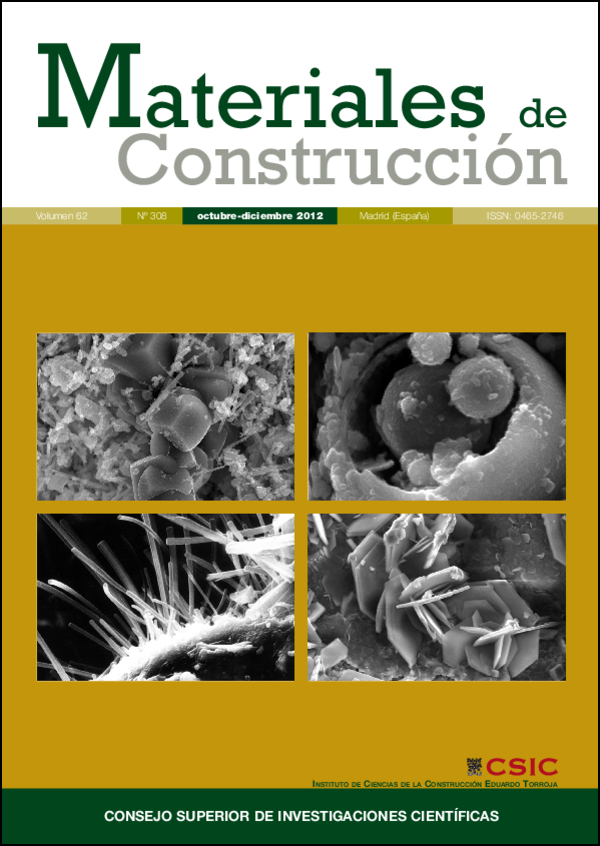Influencia de las condiciones de almacenamiento sobre la relajación de aceros de pretensado
DOI:
https://doi.org/10.3989/mc.2012.04011Palabras clave:
acero, pérdidas por relajación, enrollamiento, almacenamientoResumen
La pérdida de tensión por relajación en las armaduras activas afecta de forma importante a las estructuras de hormigón pretensado. Por ello se realizan ensayos de relajación de los alambres y cordones de pretensado tras su fabricación. Después, el material es enrollado y almacenado durante periodos que en ocasiones pueden superar el año de duración. Generalmente se desprecia la influencia que estas operaciones posteriores a la fabricación pueden tener sobre el material. Sin embargo, diversos fabricantes y suministradores han constatado experimentalmente que, en ocasiones, el material almacenado durante un periodo prolongado presenta pérdidas de relajación mayores que inmediatamente tras su fabricación. En este trabajo se realizan ensayos de laboratorio para comprobar la influencia que el radio de enrollamiento y el periodo de almacenamiento tienen sobre las pérdidas de relajación. También se propone un modelo analítico que permite predecir de manera razonablemente aproximada el valor del ensayo de relajación sobre un alambre sometido a un enrollamiento prolongado. Este modelo explica la evolución del perfil de tensiones durante el proceso de enrollamiento-almacenamiento-desenrollamiento, así como la influencia de las tensiones residuales.
Descargas
Citas
(1) EN ISO 15630-3 (2010) “Steel for the reinforcement and prestressing of concrete - Test methods”.
(2) ASTM E328-86 e1: “Standard Test Methods for Stress Relaxation Tests for Materials and Structures”, (1996)
(3) EHE-08. Instrucción de Hormigón Estructural. Publicaciones del Ministerio de Fomento. Secretaría General Técnica.
(4) Elices, M.: “Influence of residual stresses in the performance of cold-drawn pearlitic wires”. Journal of Materials Science, vol. 39, nº 12 (2004), pp.3889-3899. http://dx.doi.org/10.1023/B:JMSC.0000031470.31354.b5 http://dx.doi.org/10.1023/B:JMSC.0000031470.31354.b5
(5) Atienza, J.M.; Elices, M.: “Influence of residual stresses in the stress relaxation of cold drawn wires”, Materials and Structures, vol. 37, (2004) pp. 301-304.
(6) Sánchez-Gálvez, V.; Elices, M.; Astiz M.A.: “A new formula for stress relaxation in steels”. Materials and Structures, vol. 9, nº 54 (1976), pp. 411-417.
(7) Sánchez-Gálvez, V.: Elices, M.; “The relationship between tensile strain, creep and stress relaxation in cold-drawn steels at low temperatures”. Materials Science and Engineering, nº 78 (1986), pp. 1-8.
(8) Etienne, C.F.; Van't Spijker, F.: “The influence of prestretching on the relaxation properties of cold drawn wire for prestressed concrete”. Cement, (1967)
(9) Magura, D.: Sozen, M.; Siess, Ch.: “A study of stress relaxation in prestressing reinforcement”. PCI Journal, (1964), pp. 13-57.
(10) Elices, M.; Suárez, F.; Gálvez, J.C.; Cendón, D.A.; Atienza, J.M.: “Influence of coiling on the stress relaxation of prestressing steel wires”, Structural Concrete, vol.12, nº2 (2011), pp. 120-125.
(11) Fib. Bulletin 55. Model code 2010. First complete draft, vol. 1. Section 5.3.6, pp. 187-190.
(12) Ruiz-Hervías, J.; Atienza, J.M.; Elices, M.; Oliver, E.C.; “Optimisation of post-drawing treatments by means of neutron diffraction”, Materials Science and Engineering A, vol. 480 nº 1-2 (2008), pp. 439-448. http://dx.doi.org/10.1016/j.msea.2007.07.017
(13) Atienza, J.M.; Ruiz-Hervías, J.; Martínez-Pérez, M.L.; Mompeán, F.J.; García-Hernández, M.; Elices, M.: “Residual stresses in cold drawn pearlitic rods”. Scripta Materialia, vol. 52 (2005), pp. 1223-1228. http://dx.doi.org/10.1016/j.scriptamat.2005.03.003
(14) Martínez-Pérez, M.L. et al.: “Residual stress profiling in the ferrite and cementite phases of cold-drawn steel rods by synchrotron X-ray and neutron diffraction”. Acta Materialia, vol. 52 (2004), pp. 5303-5313. http://dx.doi.org/10.1016/j.actamat.2004.07.036
(15) Atienza, J.M.; Elices, M.: “Role of residual stresses in the stress relaxation of prestressed concrete wires”. Journal of Materials in Civil Engineering 19:8, (2007), pp. 703-707.
Descargas
Publicado
Cómo citar
Número
Sección
Licencia
Derechos de autor 2012 Consejo Superior de Investigaciones Científicas (CSIC)

Esta obra está bajo una licencia internacional Creative Commons Atribución 4.0.
© CSIC. Los originales publicados en las ediciones impresa y electrónica de esta Revista son propiedad del Consejo Superior de Investigaciones Científicas, siendo necesario citar la procedencia en cualquier reproducción parcial o total.
Salvo indicación contraria, todos los contenidos de la edición electrónica se distribuyen bajo una licencia de uso y distribución “Creative Commons Reconocimiento 4.0 Internacional ” (CC BY 4.0). Consulte la versión informativa y el texto legal de la licencia. Esta circunstancia ha de hacerse constar expresamente de esta forma cuando sea necesario.
No se autoriza el depósito en repositorios, páginas web personales o similares de cualquier otra versión distinta a la publicada por el editor.
















